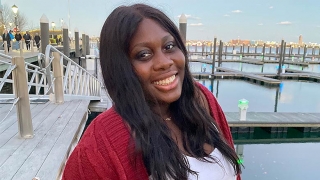Gene Therapy for Sickle Cell Disease: Marie-Chantal’s Story
Published on
Published on
Sickle cell disease is a cruel affliction. It ravages a person, both physically and mentally.
 Just ask 22-year-old Marie-Chantal. She can list countless times, big and small, when sickle cell disease impacted her life: The sadness of being a toddler who was not allowed to play in the snow because cold can trigger an episode of debilitating pain, known as a pain crisis. The dreariness of needing to take medicine every night starting at age 5. The embarrassment of being called lazy in high school because her body was too weak to climb three flights of stairs to the next class. “It was a rough road all my life,” she says.
Just ask 22-year-old Marie-Chantal. She can list countless times, big and small, when sickle cell disease impacted her life: The sadness of being a toddler who was not allowed to play in the snow because cold can trigger an episode of debilitating pain, known as a pain crisis. The dreariness of needing to take medicine every night starting at age 5. The embarrassment of being called lazy in high school because her body was too weak to climb three flights of stairs to the next class. “It was a rough road all my life,” she says.
And in her teens, Marie’s symptoms became more frequent. “I think with the stress of high school, especially in terms of deadlines for academics and AP classes, and I was also in a ton of extracurriculars — I think the stress really made my pain crises start getting worse. I was having a crisis like every two weeks.”
The pain, she says, “felt like ice almost. I would wake up and I couldn't move.” She tried over-the-counter pain medications but often needed to be admitted to a hospital for IVs of stronger medication.
As Chief of the Division of Hematology at Children’s Hospital of Philadelphia, Alexis Thompson, MD, MPH, has treated children with sickle cell disease her entire career. “This pain for some is almost indescribable,” she notes. “Not only does it cause an extraordinary burden to the individual who is suffering from this pain; imagine how this impacts their families. Pain episodes are unpredictable and may require a family to stop everything to deal with this, including the need for emergency room visits or hospitalizations. This is, in my view, the most important and most profound burden of the disease.”
Caused by a single mutation in a gene, sickle cell disease is an inherited blood disorder affecting mainly people of African and Middle Eastern descent. The mutation results in the production of abnormal hemoglobin, which is the substance in red blood cells that carries oxygen throughout the body. Normal red blood cells are smooth, round and soft, enabling them to move easily through the blood vessels to deliver oxygen. In sickle cell disease, the abnormal hemoglobin causes the red blood cells to become hard, sticky and shaped like crescents or sickles. As a result, they often get stuck when moving through the small blood vessels, causing blockages and scarring.
Damaged blood vessels in muscles and bones create severe pain. Damaged blood vessels in the chest cause a pneumonia-like condition. Damaged blood vessels in the brain can trigger a stroke. This is why sickle cell disease is so debilitating and life-threatening.
“Fortunately, with the right treatment, patients can recover from most of these episodes,” explains Timothy Olson, MD, PhD, Medical Director of CHOP’s Blood and Marrow Transplant Program. “But there is damage that is acquired over time. And unfortunately, because of the accumulation of these hits over time, the life expectancy of someone with severe sickle cell disease is only into their 40s.”
A person with sickle cell disease can take a medication that helps their red blood cells stay rounder, but its effectiveness is limited. Until very recently, the only cure has been a bone marrow transplant from a sibling donor. “Only one in four children has the match that’s desirable for those kinds of transplants,” says Dr. Thompson. Indeed, Marie’s brother — who has what’s known as the sickle cell trait but not the full-blown disease — was tested to be her donor, but he wasn’t a match. “I was devastated,” Marie reports.
 But Marie’s life changed when she was about to turn 21. She came to CHOP to participate in a clinical trial to receive a groundbreaking gene therapy that, in the simplest terms, corrects the problem that causes sickle cell disease. The clinical trial was open to patients ages 12 to 35 who had significant complications of sickle cell disease, such as recurrent episodes of severe pain and/or acute chest syndrome. The therapy was developed by Vertex and CRISPR Therapeutics, and on Dec. 8, 2023, was approved for use by the U.S. Food and Drug Administration, with the brand name CASGEVY™. It is the first FDA-approved therapy based on the Nobel Prize-winning CRISPR technology.
But Marie’s life changed when she was about to turn 21. She came to CHOP to participate in a clinical trial to receive a groundbreaking gene therapy that, in the simplest terms, corrects the problem that causes sickle cell disease. The clinical trial was open to patients ages 12 to 35 who had significant complications of sickle cell disease, such as recurrent episodes of severe pain and/or acute chest syndrome. The therapy was developed by Vertex and CRISPR Therapeutics, and on Dec. 8, 2023, was approved for use by the U.S. Food and Drug Administration, with the brand name CASGEVY™. It is the first FDA-approved therapy based on the Nobel Prize-winning CRISPR technology.
On the same day, another type of therapy for sickle cell disease was also approved by the FDA. Called LYFGENIA™, that product is manufactured by bluebird bio and uses a cell-based gene therapy.
Dr. Thompson, who was involved with the early development of gene therapy clinical trials, says, “More than 90% of individuals are pain-free following gene therapy. That’s an extraordinary accomplishment.”
Marie is part of that 90%.
Stephan Grupp, MD, PhD, Chief of the Cellular Therapy and Transplant Section, oversaw the Vertex (CASGEVY) trial at CHOP, which was one of multiple hospitals that participated in the trials. He also chaired the international study committee for the trial. Dr. Grupp describes how the gene therapy works:
“We are able to take cells from a patient and fix the genetic problem that causes them to have sickle cell disease,” he says, “and then we give them their own corrected cells back.”
Specifically, bone marrow stem cells are extracted from patients and then edited in a lab so they produce a normal type of hemoglobin. The patient then undergoes chemotherapy to wipe out the stem cells with the sickle cell mutation and to “make space” in the bone marrow for new cells. After that, doctors infuse the lab-edited stem cells back into the patient’s body, where they grow and multiply. The procedure is essentially a bone marrow transplant, but safer. It does not require a donor, and because it uses the patient’s own cells, it eliminates the chance that the patient’s body will reject the transplant, as well as significantly reducing other risks of transplant.
“This current approach has been transformational,” says Dr. Thompson.
“It’s mind blowing to think of where we are today relative to where we were a decade ago,” adds Dr. Olson. But all the physician-scientists involved in the trials point out that the patients who received the therapy must be followed for a long time. “We are very hopeful that this is going to be a long-term cure, but we’re also cautious in labeling things as a cure,” Dr. Olson explains. “And to prove that this therapy is that long-term cure, we need to follow these patients for many years to see how they’ve done.”
Marie, though, is confident: “I feel that I’ve been cured of sickle cell. It’s like a weight has been lifted off. I can do things without anxiety now. You have to rewire your brain almost.”
While Marie is finishing up her last semester at Cornell University and has a job lined up as a management consultant at a major accounting firm, she can now envision a much longer future for herself than she could when she first began her studies.
“The life expectancy of a woman with sickle cell disease ranges from like 30s to 50s maybe,” Marie says. “I would be like, OK, this is the hand I’m dealt. But now, I can see myself living to 80s, 90s. I can imagine the life I’ll have for myself, the life I’ve built for myself, and my future family. And I’m incredibly excited for it.”